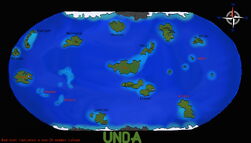Unda (OON-duh) is the planet from which the crew and passengers of the Ingenuity originated.
Physical Characteristics[]
Unda is comprised of a number of islands.

A map of Unda as of the Ingenuity's departure. Non-IU-member nations are written in red. (Click the image and then "view full image" in the top left to see in detail)
The equatorial region regularly experienced severe storms, due to the large swaths of warm ocean water between islands. Consequently, the equatorial islands were uninhabited for much of Unda's history.
Human History[]
It is believed that humanity originated on Ilona and Ilesar, many thousands of years ago when they were one island, Ilaria. Archaeological and linguistic evidence has indicated that over time, there were a series of migrations away from this island. The first of these occurred over 12,000 years ago, and was thought to be prompted by a series of harsh storms. People travelled first up to Chanost, and then over to Merraska, Caalgen, and Bhalua. The second wave of migration was around 10,000 years ago, to Lornith, Nezuma, Skobra and Griesh. There was another wave of migration around -3500, to Tekal and Laku, and the last to Helmi around -2500.
Early written history has conclusively demonstrated that in the years following these migrations, there was contact between Ilona and Ilesar, Chanost and Merraska, Laku and Helmi, Caalgen and Bhalua, and Nezuma and Skobra. Skobra also likely had contact with Lornith.
See also: Undan Timeline.
Undan Languages[]
The first language spoken by humans is known as Old Ilarian.
Following the first wave of migration, the people of Chanost, Merraska, Caalgen and Bhalua were each isolated for thousands of years, leading to a lack of linguistic cohesion and the development of unrelated languages.
On Chanost, three separate languages developed in the Eastern, Western, and Southern regions. A writing system was developed first for Southern Chanostan, and was modified for use with Eastern and Western Chanostan. Following the beginning of trade with Merraska, Merraskan acquired a number of Southern Chanostan loan words, as well as a subset of the orthography.
Bhalua developed a writing system, which was similarly shared with the people of Caalgen once they began trading. It was heavily modified for use with Caalgenese, but similarities are still present.
The people of Lornith and Griesh similarly developed their own languages and systems of writing over time. Each island in the Nezuman and Skobran archipelagos developed their own dialect of Nezuman and Skobran, respectively. (These may well be separate languages rather than separate dialects, but the IU ban on the use of Nezuman and Skobran has made research in this field nigh-impossible.) There were not traditional written forms of Nezuman or Skobran.
As time passed, Old Ilarian became New Ilarian, and an alphabet was developed. New Ilarian and its alphabet spread with the migrations to Tekal, Laku, and Helmi. As Tekali and Lakuan diverged from Ilarian, the orthography used was modified accordingly.
On Helmi, there were two distinct groups of people (one clustered around Tunturi Mountain and one along the eastern coast), and two separate languages developed: Upper and Lower Helmite. The Lower Helmitic orthography was altered from that of Ilarian, but there were few changes made in the formation of the Upper Helmitic orthography.
Following the rise in sea level that separated Ilaria into Ilona and Ilesar in the -2000s, Ilarian split into Ilonan and Ilesarian. The waters of the coast to the east of Ilona rapidly developed reefs due to the high temperature of the water, preventing East ilonan participation in the maritime trade that connected the rest of the island. This isolation led to the divergence of East Ilonan.
Once the people of Tekal, Ilona, and Ilesar came into contact again, they developed a common language based off of Tekali and Ilonan, which became Cosprak.